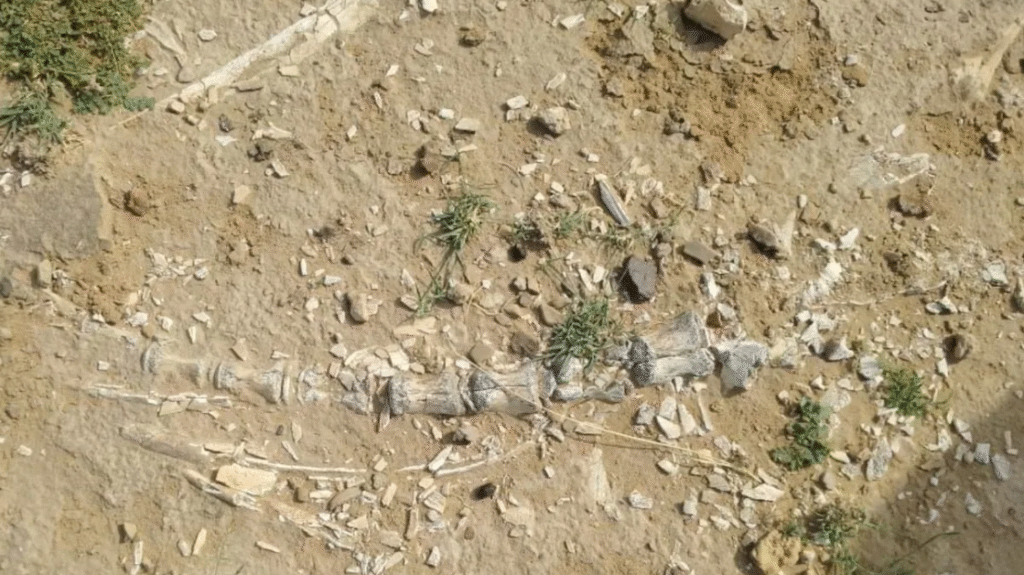In a groundbreaking paleontological discovery, researchers from Jai Narayan Vyas University, Jodhpur, have unearthed India’s first-ever phytosaur fossil, dating back nearly 200 million years. Found in Megha village, this crocodile-like reptile is offering the world fresh insights into prehistoric aquatic ecosystems that once dominated the Indian subcontinent.
A Glimpse Into the Mesozoic: The Phytosaur Unearthed
A team led by earth scientist Professor V.S. Parihar discovered the 1.5–2 meter skeleton embedded in the Jurassic-era Lathi Formation. Complementing the rare find was an egg fossil, hinting at reproductive behaviour—a first in India. Being only the second such phytosaur fossil found globally, it places Megha village on the world map of fossil-rich regions.
What Are Phytosaurs? Ancient River Predators
Phytosaurs—named from Greek for “plant lizards” due to early misidentifications—were semi-aquatic archosaurs, resembling crocodiles but unrelated to them. They roamed during the Late Triassic to Early Jurassic, surviving the mass extinction that ended the Permian era. Their nostrils, positioned near the eyes, possibly aided breathing while submerged. These reptiles preyed mainly on fish and thrived in riverine ecosystems across Pangea.
Jaisalmer’s Fossil Treasure Trove
The excavation site spans nearly 20 km, extending toward the Akal Wood Fossil Park, embedded in Jurassic sandstones, marl, and limestone. Authorities have secured the site following further sightings of potential flying herbivorous dinosaur remains nearby. Geologists believe the region could hold more fossilized secrets.
India’s Paleontological Breakthrough
This discovery marks a new era for Indian geology. Previously, fossils like Tharosaurus indicus—a dinosaur from 167 million years ago—highlighted Jaisalmer’s potential. Now, the phytosaur find not only confirms the existence of ancient aquatic reptiles but reinforces the region’s role in Jurassic-era studies.
Significance of the Find
| Feature | Insight |
|---|---|
| New Record for India | First well-preserved phytosaur in the country; globally rare find. |
| Paleoecological Clues | Egg suggests reproductive behavior and nesting areas. |
| Geological Insight | Supports Lathi Formation as a rich paleontological reserve. |
| Tourism & Research | Potential to develop geo-tourism and attract scientific explorations. |
Context: Phytosauria in the Fossil Record
Phytosaurs are broadly distributed in Triassic and early Jurassic strata across continents, with fossils also found in North America, Europe, and Madagascar. Their unique morphology and preserved features make them crucial to understanding reptilian evolution and ecosystem dynamics in Pangea.
Notably, India has featured in phytosaur research before—with Colossosuchus techniensis, a giant species over 8 meters long from the Tiki Formation, related to the phytosaur lineage.
What’s Next for Jaisalmer’s Jurassic Herd
With such a landmark find, paleontologists are now mapping the potential of the Jaisalmer Basin as a fossil hub. Efforts include:
- Expanded excavations for more fossils
- Geological survey of surrounding strata
- Preservation and possible geo-tourism around Megha village
The find also provides material for academic research and global scientific collaboration.
Conclusion
India’s first phytosaur fossil is not merely a museum piece; it is a deep-time bridge to the planet’s prehistoric past. Unearthed from the sands of Jaisalmer, this crocodile-like reptile opens a window into ecosystems that flourished 200 million years ago. Megha village may yet emerge as a shining star in the annals of paleontology, inspiring further exploration and enriching our understanding of Earth’s ancient landscapes.
To read more Indian Laws and news, visit Legal Guide India



